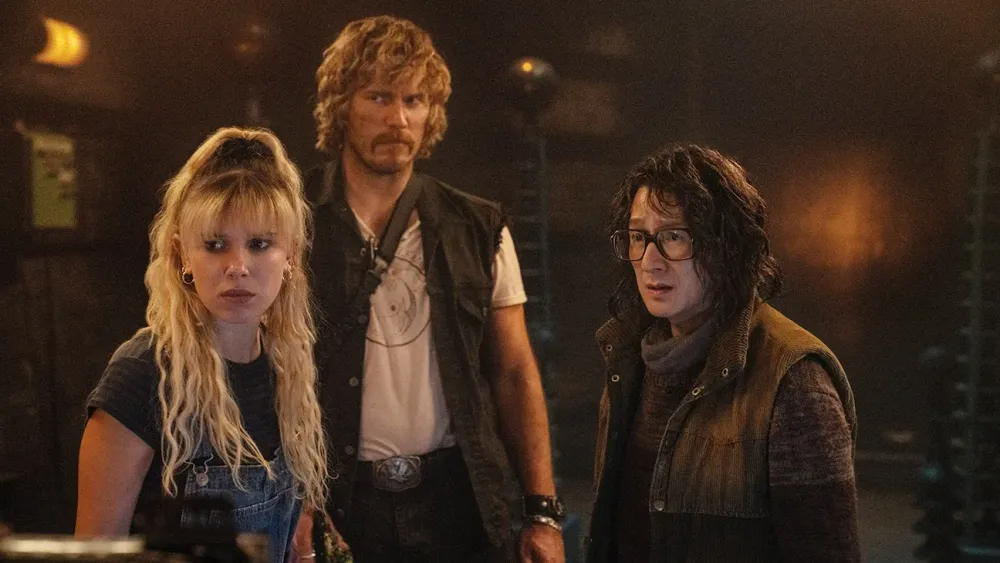An unbelievable $320 million USD is reportedly how much the Netflix Russo brother’s streaming title The Electric State cost. It’s expensive in the manner that a Chanel boomerang is expensive: a product designed and divorced from the significance it is unwilling to engage with. Blasé would be one way to describe the phenomenon, offensively tone deaf would be another.
The Electric State isn’t turning an Aboriginal artefact into a luxury consumer knickknack and wilfully using cultural appropriation for profit: however, the hyperbolic comparison aside, the movie is proof that sometimes when money talks it says nothing. Or worse, it parades its blatant disregard.
Set in an alternate 1990s where robots initially built by Walt Disney in 1955 to promote his theme parks have become a sentient and angry unpaid working class (what is that called again?) Led by Planters’ Mr. Peanut (Woody Harrelson), the robot uprising led to a state of war. Tech guru Ethan Skate (Stanley Tucci) stepped in to help the troops fight the indefatigable enemy with the Neurocaster, a device which enabled humans to cast their consciousness into an otherwise inert robot body. Sentre’s tech helped humanity win the war and the robots were placed in an exclusion zone. Post war the Neurocaster is used by most of society and integrated into almost everyone’s life where their consciousness is bifurcated. If that sounds like a bad idea, it’s because it absolutely is.
Foster teen Michelle Greene (Millie Bobby Brown) is having a tough time after her parents and genius younger brother, Christopher (Woody Norman) died in a car accident. Michelle is a Neurocaster refuser preferring to “live in reality.” One night she is visited by a robot representation of Christopher’s favourite cartoon character, Kid Cosmo (Alan Tudyk) who claims through pre-programmed character voice grabs that it is being controlled by the real Christopher. Immediately she’s on the run with an illegal robot tracking down Christopher in the heart of the exclusion zone (the EX). Teaming up with ex-veteran and now petty criminal and pop culture collector, Keats (Chris Pratt) she has to uncover a vast conspiracy regarding Sentre’s technology and the villains who make use of it.
Even if you have zero familiarity with Simon Stålenhag’s 2018 illustrated novel which forms the inspiration for the movie, you know exactly what kind of character traits Chris Pratt is going to lean on. He ‘amusingly’ squabbles with his bot buddy Herman (Anthony Mackie), he’s cynical and reckless but with a heart of gold. The plot itself is as obvious as Pratt’s characterisation. The bad guy has a narrative neon sign pulsing above his head reading “irredeemably evil.” Every narrative beat is scraped from somewhere else — from the doctor who regrets what he got involved in (Ke Huy Quan) through to the redundant final address to the virtual reality numbed populace.
Writers Stephen McFeely and Christopher Markus vaguely attempt to add a message to the movie. Something along the lines of slavery is (generally) bad and humans are too easily lulled into surrendering their psyches to techno-comfort. Irony is profoundly absent with one scene where the good guys battle the bad guys to the strains of Wagner’s ‘Ride of the Valkyrie’ urging them on. The Russos might have missed the memo about Richard Wagner’s proto-fascist beliefs and completely misread that Francis Ford Coppola wasn’t cheering the Americans in Vietnam when he included it in Apocalypse Now.
That single example is one of dozens. Is there anything being said about drone warfare beginning in the early 1990s? Nope. Considering the current tech-bro shadow running the United States government and helping a modern-day despot put workers in camps? Not really. But there are heaps of shiny nostalgia serotonin hits to beat the brain into submission so asking basic questions about the historical positionality of the dystopia melt away when Judas Priest’s ‘Breaking the Law’ booms as the good bots go ‘pew pew pew’ against EVILCORP TM.
It doesn’t matter that high quality and popular actors like Giancarlo Esposito, Holly Hunter, Colman Domingo, Jenny Slate, and Brian Cox signed on for large or small roles, nor how hard they try to act their way around the script. The Russo brothers decided that putting a bunch of elements and tropes from “stuff people liked” into a blender and sloppily pouring it out was all they need to do to make a blockbuster.
Assuming audiences liked Chris Pratt as Star-Lord in the MCU, and they dug Millie Bobby Brown as Eleven in Stranger Things plus a retro nostalgia for Steven Spielberg’s E.T. so feeding more of those elements through a watery drip tube doesn’t make a movie. It’s as the big bad says, “Who cares? Our world is a tyre fire floating on an ocean of piss.” That’s the tagline for the effort put into The Electric State. Who cares? The cheque is in the bank and the audience’s partial attention has cashed it.
The Electric State isn’t a movie, it’s an experiment conducted on the audience to determine how much dross they’ll tolerate.
Directors: Anthony Russo, Joe Russo
Cast: Millie Bobby Brown, Chris Pratt, Giancarlo Esposito
Writers: Christopher Marcus, Stephen McFeely, (based on the book by Simon Stålenhag)
Producers: Chris Castaldi, Mike Larocca, Thiago Da Costa, Benoit Jaubert, Anthony Russo, Joe Russo, Patrick Newall, Georgina Pope, Angela Russo-Otstot
Music: Alan Silvestri
Cinematography: Stephen F. Windon
Editing: Jeffrey Ford
Streaming Availability:

